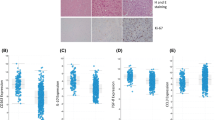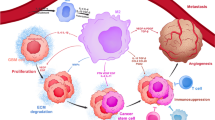Abstract
The aim of this study is to investigate the expression of tumor-associated macrophages (TAMs) M1, M2 phenotypic in human glioma tissues, and to explore the clinical significance and prognostic value of TAMs in glioma patients. A total of 50 glioma samples were obtained from patients diagnosed in our hospital from 2007 to 2010. Clinical follow-up was conducted via return visits and telephone interviews after discharge. Progression free survival (PFS) was calculated based on tumor progression by MRI and CT examination from the primary operation. Overall survival (OS) time was calculated from the initial surgical operation date to end date of follow-up or death. Kaplan–Meier methodology was used to evaluate the survival of patients and log-rank test for comparing differences between groups. The expression levels of CD16 and CD206 were investigated in the 4 μm serial paraffin sections by immunohistochemistry. M1-type macrophages filtrated in all the grades of glioma samples, and the lower expression level was associated with high grade glioma. A negative correlation was found between WHO pathological grades and the expression of M1-type macrophages by Spearman correlation analysis. M2-type macrophages filtrated in all the grades of glioma samples with the higher expression level associated with high grade glioma. A positive correlation was found between WHO pathological grades and the expression of M2-type macrophages by Spearman correlation analysis. The PFS and OS among patients with high levels of M1-type macrophages (CD16+++) were significantly higher than those with less expression. The PFS and OS among patients with high levels of M2-type macrophages (CD206+++) were significantly lower than those with low expression. M1-type macrophages may inhibit the tumor growth and improve the therapeutic outcome of glioma patients. M2 ratios are associated with tumor proliferation and poor prognosis. TAMs phenotypes of glioma samples are the potential biomarkers in assessing the degree of malignancy, tumor invasion, and patient prognosis in clinic.




Similar content being viewed by others
References
Huse, J. T., & Holland, E. C. (2010). Targeting brain cancer: Advances in the molecular pathology of malignant glioma and medulloblastoma. Nature Reviews Cancer, 10(5), 319–331.
Louis, D. N., et al. (2007). The 2007 WHO classification of tumours of the central nervous system. Acta Neuropathologica, 114(2), 97–109.
Liu, S., et al. (2012). CD8+ lymphocyte infiltration is an independent favorable prognostic indicator in basal-like breast cancer. Breast Cancer Research, 14(2), R48.
Deschoolmeester, V., et al. (2010). Tumor infiltrating lymphocytes: An intriguing player in the survival of colorectal cancer patients. BMC Immunology, 11, 19.
Cui, X., et al. (2013). Analysis of CD137L and IL-17 expression in tumor tissue as prognostic indicators for glioblastoma. International Research Journal of Biological Sciences, 9(2), 134–141.
Casulo, C., et al. (2013). Tumor associated macrophages in relapsed and refractory Hodgkin lymphoma. Leukemia Research, 37(9), 1178–1183.
da Fonseca, A. C., & Badie, B. (2013). Microglia and macrophages in malignant gliomas: recent discoveries and implications for promising therapies. Clinical and Developmental Immunology, 2013, 264124.
Kennedy, B. C., et al. (2013). Tumor-associated macrophages in glioma: friend or foe? Journal of Oncology, 2013, 486912.
Fleming, A. J., & Chi, S. N. (2012). Brain tumors in children. Current Problems in Pediatrics and Adolescent Health Care, 42(4), 80–103.
Hartmann, C., et al. (2013). Long-term survival in primary glioblastoma with versus without isocitrate dehydrogenase mutations. Clinical Cancer Research, 19(18), 5146–5157.
Bogler, O., et al. (1995). The p53 gene and its role in human brain tumors. Glia, 15(3), 308–327.
Stupp, R., et al. (2005). Radiotherapy plus concomitant and adjuvant temozolomide for glioblastoma. New England Journal of Medicine, 352(10), 987–996.
Guo, C., et al. (2013). The role of tumor-associated macrophages in tumor vascularization. Vascular Cell, 5(1), 20.
Charles, N. A., et al. (2012). The brain tumor microenvironment. Glia, 60(3), 502–514.
Miescher, S., et al. (1988). In situ characterization, clonogenic potential, and antitumor cytolytic activity of T lymphocytes infiltrating human brain cancers. Journal of Neurosurgery, 68(3), 438–448.
Zhang, B., et al. (2011). M2-polarized tumor-associated macrophages are associated with poor prognoses resulting from accelerated lymphangiogenesis in lung adenocarcinoma. Clinics (Sao Paulo), 66(11), 1879–1886.
Ding, T., et al. (2009). High tumor-infiltrating macrophage density predicts poor prognosis in patients with primary hepatocellular carcinoma after resection. Human Pathology, 40(3), 381–389.
Quatromoni, J. G., & Eruslanov, E. (2012). Tumor-associated macrophages: Function, phenotype, and link to prognosis in human lung cancer. American Journal of Translational Research, 4(4), 376–389.
Lievense, L. A., et al. (2013). Tumor-associated macrophages in thoracic malignancies. Lung Cancer, 80(3), 256–262.
Sica, A., & Mantovani, A. (2012). Macrophage plasticity and polarization: In vivo veritas. Journal of Clinical Investigation, 122(3), 787–795.
Siveen, K. S., & Kuttan, G. (2009). Role of macrophages in tumour progression. Immunology Letters, 123(2), 97–102.
Bingle, L., Brown, N. J., & Lewis, C. E. (2002). The role of tumour-associated macrophages in tumour progression: Implications for new anticancer therapies. Journal of Pathology, 196(3), 254–265.
Baay, M., et al. (2011). Tumor cells and tumor-associated macrophages: Secreted proteins as potential targets for therapy. Clinical and Developmental Immunology, 2011, 565187.
Buford, T. W., & Anton, S. D. (2014). Resveratrol as a supplement to exercise training: friend or foe? Journal of Physiology, 592(Pt 3), 551–552.
Acknowledgments
This study was supported by a special grant for High-Level Training of Yun Nan (D201230) and a special joint grant of Yunnan Provincial Science and Technology Department and Kunming Medical University (2013FZ281 and 2010CD157).
Author information
Authors and Affiliations
Corresponding author
Additional information
Peng Ding and WeiMin Wang contributed equally to this study.
Rights and permissions
About this article
Cite this article
Ding, P., Wang, W., Wang, J. et al. Expression of Tumor-Associated Macrophage in Progression of Human Glioma. Cell Biochem Biophys 70, 1625–1631 (2014). https://doi.org/10.1007/s12013-014-0105-3
Published:
Issue Date:
DOI: https://doi.org/10.1007/s12013-014-0105-3




